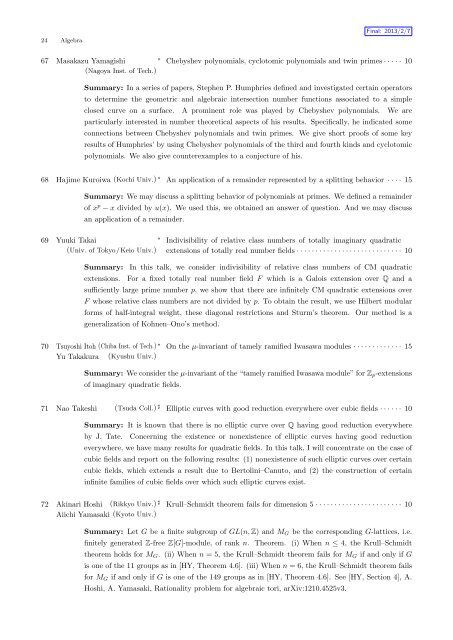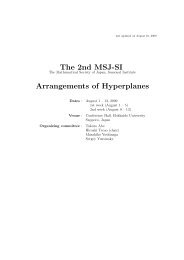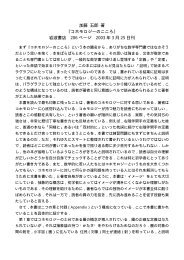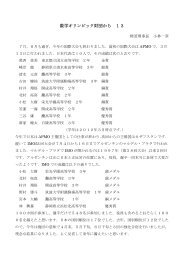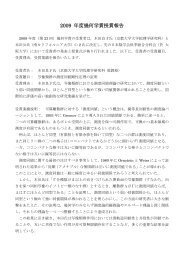Titles and Short Summaries of the Talks
Titles and Short Summaries of the Talks
Titles and Short Summaries of the Talks
You also want an ePaper? Increase the reach of your titles
YUMPU automatically turns print PDFs into web optimized ePapers that Google loves.
24 Algebra<br />
Final: 2013/2/7<br />
67 Masakazu Yamagishi<br />
(Nagoya Inst. <strong>of</strong> Tech.)<br />
∗ Chebyshev polynomials, cyclotomic polynomials <strong>and</strong> twin primes · · · · · 10<br />
Summary: In a series <strong>of</strong> papers, Stephen P. Humphries defined <strong>and</strong> investigated certain operators<br />
to determine <strong>the</strong> geometric <strong>and</strong> algebraic intersection number functions associated to a simple<br />
closed curve on a surface. A prominent role was played by Chebyshev polynomials. We are<br />
particularly interested in number <strong>the</strong>oretical aspects <strong>of</strong> his results. Specifically, he indicated some<br />
connections between Chebyshev polynomials <strong>and</strong> twin primes. We give short pro<strong>of</strong>s <strong>of</strong> some key<br />
results <strong>of</strong> Humphries’ by using Chebyshev polynomials <strong>of</strong> <strong>the</strong> third <strong>and</strong> fourth kinds <strong>and</strong> cyclotomic<br />
polynomials. We also give counterexamples to a conjecture <strong>of</strong> his.<br />
68 Hajime Kuroiwa (Kochi Univ.) ∗ An application <strong>of</strong> a remainder represented by a splitting behavior · · · · 15<br />
Summary: We may discuss a splitting behavior <strong>of</strong> polynomials at primes. We defined a remainder<br />
<strong>of</strong> x p − x divided by u(x). We used this, we obtained an answer <strong>of</strong> question. And we may discuss<br />
an application <strong>of</strong> a remainder.<br />
69 Yuuki Takai<br />
∗ Indivisibility <strong>of</strong> relative class numbers <strong>of</strong> totally imaginary quadratic<br />
(Univ. <strong>of</strong> Tokyo/Keio Univ.) extensions <strong>of</strong> totally real number fields · · · · · · · · · · · · · · · · · · · · · · · · · · · · 10<br />
Summary: In this talk, we consider indivisibility <strong>of</strong> relative class numbers <strong>of</strong> CM quadratic<br />
extensions. For a fixed totally real number field F which is a Galois extension over Q <strong>and</strong> a<br />
sufficiently large prime number p, we show that <strong>the</strong>re are infinitely CM quadratic extensions over<br />
F whose relative class numbers are not divided by p. To obtain <strong>the</strong> result, we use Hilbert modular<br />
forms <strong>of</strong> half-integral weight, <strong>the</strong>se diagonal restrictions <strong>and</strong> Sturm’s <strong>the</strong>orem. Our method is a<br />
generalization <strong>of</strong> Kohnen–Ono’s method.<br />
70 Tsuyoshi Itoh (Chiba Inst. <strong>of</strong> Tech.) ∗ On <strong>the</strong> µ-invariant <strong>of</strong> tamely ramified Iwasawa modules · · · · · · · · · · · · · 15<br />
Yu Takakura (Kyushu Univ.)<br />
Summary: We consider <strong>the</strong> µ-invariant <strong>of</strong> <strong>the</strong> “tamely ramified Iwasawa module” for Zp-extensions<br />
<strong>of</strong> imaginary quadratic fields.<br />
71 Nao Takeshi (Tsuda Coll.) ♯ Elliptic curves with good reduction everywhere over cubic fields · · · · · · 10<br />
Summary: It is known that <strong>the</strong>re is no elliptic curve over Q having good reduction everywhere<br />
by J. Tate. Concerning <strong>the</strong> existence or nonexistence <strong>of</strong> elliptic curves having good reduction<br />
everywhere, we have many results for quadratic fields. In this talk, I will concentrate on <strong>the</strong> case <strong>of</strong><br />
cubic fields <strong>and</strong> report on <strong>the</strong> following results: (1) nonexistence <strong>of</strong> such elliptic curves over certain<br />
cubic fields, which extends a result due to Bertolini–Canuto, <strong>and</strong> (2) <strong>the</strong> construction <strong>of</strong> certain<br />
infinite families <strong>of</strong> cubic fields over which such elliptic curves exist.<br />
72 Akinari Hoshi (Rikkyo Univ.) ♯ Krull–Schmidt <strong>the</strong>orem fails for dimension 5 · · · · · · · · · · · · · · · · · · · · · · · 10<br />
Aiichi Yamasaki (Kyoto Univ.)<br />
Summary: Let G be a finite subgroup <strong>of</strong> GL(n, Z) <strong>and</strong> MG be <strong>the</strong> corresponding G-lattices, i.e.<br />
finitely generated Z-free Z[G]-module, <strong>of</strong> rank n. Theorem. (i) When n ≤ 4, <strong>the</strong> Krull–Schmidt<br />
<strong>the</strong>orem holds for MG. (ii) When n = 5, <strong>the</strong> Krull–Schmidt <strong>the</strong>orem fails for MG if <strong>and</strong> only if G<br />
is one <strong>of</strong> <strong>the</strong> 11 groups as in [HY, Theorem 4.6]. (iii) When n = 6, <strong>the</strong> Krull–Schmidt <strong>the</strong>orem fails<br />
for MG if <strong>and</strong> only if G is one <strong>of</strong> <strong>the</strong> 149 groups as in [HY, Theorem 4.6]. See [HY, Section 4], A.<br />
Hoshi, A. Yamasaki, Rationality problem for algebraic tori, arXiv:1210.4525v3.


